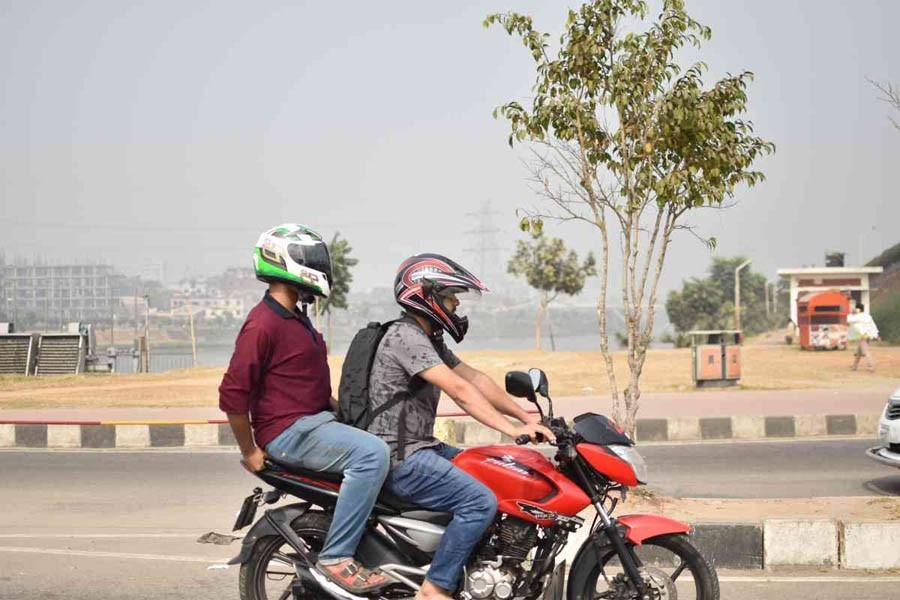Unlike many other corona-hit countries, day-to-day life in Bangladesh is slowly returning to normal. The spectacle is encountered especially in the urban areas, in capital Dhaka in particular. It occurred in a gap of just one and half months. The scene can be detected in the streams of pedestrians on the roads. Almost all of them look apparently healthy. The health authorities' regular tally of the number of affected persons and fatalities continues to decline. Lots of people are found moving in the city and the suburbs, abiding by the government directive of mandatorily wearing of facemasks. Meanwhile, the mass vaccination programme has started at many specialised centres.
In spite of this semblance of normality, tentatively called 'new normal', the ever cautious people detect a number of signs which smack of gross deviations and Dhaka's characteristic recklessness. The road and traffic movement sector can be singled out as a prominent one. One can turn to the public buses. Just remember their humble style of wooing passengers in the first couple of weeks after their start of plying the short and long routes. Few private buses could be detected in those days without their helpers standing at the bus-doors to spray sanitisers on the hands of passengers. As days went by, the sanitising sprays began to be used on entreaties or after short heated exchanges of words. A similar picture was seen at the entrance of government markets and public service points. They were followed by a few private banks, large and small shopping malls and the other offices visited by service seekers without pause. In a short time, however, the use of sanitisers began petering out.
A new troubling scene, however, has emerged in the sector of ride hailing services --- including both cars and motorbikes. Although it took a long time for the ride-sharing services to be widely visible on the Dhaka roads, they are now quite omnipresent in the capital. At present, there are few busy street corners in the capital, which do not have at least a dozen ride hailing motorbikes waiting for passengers. Compared to the 'Uber' cars, the 'Pathao' motorbikes have been more popular among the passengers since their early days. Due to their smaller size and smooth maneuverability, the motorcycles kept gaining popularity fast among the young male pillion passengers.As they returned following the 7-month corona shutdown, these motorbikes wore a new look. Not that the two-wheelers supposedly smelt of new features because they have rolled out on roads after a long time; the reason lay elsewhere.
To the utter incredulity of the intending ride-sharers, lots of the bike owners were found to be without a satisfactory knowledge about the sprawling metropolis of Dhaka. Except some major areas and VIP roads, most of them expressed their ignorance about the less-known but major thoroughfares, and the newly developed neighbourhoods and their exact locations. These deficiencies are least expected by passengers from the ride hailing services. As Dhaka's traffic movement experts view it, the post-shutdown ride-hailing vehicle drivers swarming on Dhaka mostly belong to the rural or semi-urban backdrops. They are used to carrying pillion passengers on their motor bikes in exchange of rents depending on distance from one spot to another. These are common spectacles in areas having roads suitable for travel by motorbikes. These semi-concrete roads are not uncommon in many vast rural areas.
Upon being seasoned on operating motorbikes in areas that have hardly seen traffic gridlocks like those in Dhaka, these motorbike operators initially remain baffled upon reaching the capital. But they have come to the big city to earn a living by giving pillion ridesto people. Many of them find it difficult to get used to the app-based device of the riding network. As a result, a large section of the youths reaching Dhaka in search of a livelihood end up being ordinary motorbike operators giving ride to people in need of reaching a destination in a short time. They remain outside the ride hailing app's radius. The fare of these pillion rides is fixed through bargaining. On occasions, it resembles the style of cycle-rickshaw hiring. Like in this case, an invisible competition remains present in motorbike hiring as well. At times, a cunning motorbike-owner makes a hefty profit, on another occasion he is taken for a ride by a city-bred smart youth.
This practice is unhealthy, and cannot become a welcome trend in a modern city. A most dreadful aspect of the on-hire motorbike operation is its ominous role in the increase of accidents, many of them fatal, on the Dhaka roads. Apart from their ignorance about the basic traffic rules in operation in Dhaka metropolis, they have sketchy or no idea of many roads and areas in the bustling city. A lot of them are excellent at operating their bikes in small towns or semi-urban villages. But their skill and expertise hardly work in Dhaka. All this, plus their educational deficiency, adds to the plight of the inept bike ride sharing.
Blaming only the rookie motorbike operators offering service to Dhaka-dwellers for the present anarchic situation in the sector might amount to injustice. Youths born in the city and growing up on being hooked on the two-wheelers also get befuddled after employing their skill as capital to an income-generating occupation involving motorcycles. What they lack is the willingness to abide by the strict regimen of traffic discipline. There are little scopes for showing one's heroic exploits or recklessness while engaged in this profession. At the same time, youths devoid of the required skill and the eagerness to develop acquaintance with a city's unique realities eventually fail in achieving their goal --- landing a permanent income-generation platform. Orientation, imparting training and teaching the confused motorcyclists how to respect law and abide by rules can help them weather their present crisis.


